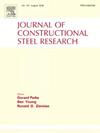Improved shear buckling resistance model for hybrid I-girders with slender web
IF 4
2区 工程技术
Q1 CONSTRUCTION & BUILDING TECHNOLOGY
引用次数: 0
Abstract
The present study focuses on examining the shear buckling behavior and the interaction between shear and bending (M–V interaction) in longitudinally unstiffened girders with slender webs. The applicability of the existing shear buckling resistance model, given in EN 1993-1-5, is evaluated through comprehensive numerical analysis. Based on the results, an enhanced design equation is proposed to improve accuracy, optimize safety, and cost-efficiency in the design of hybrid girders. The parametric numerical investigation indicates that the contribution of the flange to shear buckling resistance does not conform to the current EN 1993-1-5 rules. Specifically, for girders with lightweight flanges, the existing approach underestimates the flange's contribution, leading to overly conservative resistances. Conversely, for I-girders with heavy flanges, the current method may produce unsafe predictions. Moreover, the study identifies inconsistencies and inaccuracies in the present design equation for hybrid girders, showing that the current resistance model does not accurately reflect the shear capacity of hybrid configurations. Therefore, a new, refined design formula is proposed to more accurately estimate the flange contribution, aligning closely with numerical simulation results.
细长腹板混合工字梁抗剪屈曲抗力改进模型
本文主要研究了细长腹板纵向无加劲梁的剪切屈曲行为和剪切-弯曲相互作用(M-V相互作用)。通过综合数值分析,对en1993 -1-5给出的现有抗剪切屈曲模型的适用性进行了评价。在此基础上,提出了一种改进的设计方程,以提高混合梁的设计精度、优化安全性和成本效益。参数数值研究表明,法兰对抗剪切屈曲的贡献不符合现行en1993 -1-5的规定。具体来说,对于带有轻质法兰的梁,现有的方法低估了法兰的贡献,导致阻力过于保守。相反,对于带有重型法兰的工字梁,目前的方法可能会产生不安全的预测。此外,研究还发现了现有混合梁设计方程中的不一致和不准确之处,表明当前的阻力模型不能准确反映混合结构的抗剪能力。因此,提出了一种新的、改进的设计公式,以更准确地估计法兰的贡献,与数值模拟结果接近。
本文章由计算机程序翻译,如有差异,请以英文原文为准。
求助全文
约1分钟内获得全文
求助全文
来源期刊

Journal of Constructional Steel Research
工程技术-工程:土木
CiteScore
7.90
自引率
19.50%
发文量
550
审稿时长
46 days
期刊介绍:
The Journal of Constructional Steel Research provides an international forum for the presentation and discussion of the latest developments in structural steel research and their applications. It is aimed not only at researchers but also at those likely to be most affected by research results, i.e. designers and fabricators. Original papers of a high standard dealing with all aspects of steel research including theoretical and experimental research on elements, assemblages, connection and material properties are considered for publication.
 求助内容:
求助内容: 应助结果提醒方式:
应助结果提醒方式:


